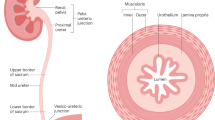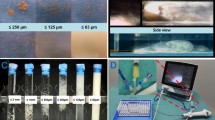Summary
The ability to predict how easily a stone will break in response to extracorporeal and intracorporeal lithotripsy would be advantageous for the urologist. In a study of fragments from 52 urinary calculi, in vitro microhardness results were found to increase for the series struvite to brushite. Ultrasound velocity measurements performed on 35 intact urinary stones showed a similar trend. This suggests that ultrasound velocity may be a useful indicator of stone strength and one which could be used in vitro to assist the planning of stone treatment.
Similar content being viewed by others
References
Alken P, Hutschenreiter G, Günther R, Marberger M (1981) Percutaneous stone manipulation. J Urol 463–465
Burns JR, Shoemaker BE, Gauthier JF, Finlayson B (1985) Hardness testing of urinary calculi. In: Schwille PO, Smith LH, Robertson WD, Vahlensieck W (eds) Urolithiasis and related clinical research. Plenum Press, London, pp 703–706
Chaussy C, Brendel W, Schmiedt E (1980) Extracorporeally induced destruction of kidney stones by shockwaves. Lancet II:1265–1266
Coleman AJ, Saunders JE (1987) Comparison of extracorporeal shockwave lithotripters. In: Coptcoat, Miller, Wickham (eds) Lithotripsy II. BDI, pp 121–131
Cohen NP, Parkhouse H, Scott ML, Bowsher WG, Crocker P, Whitfield HN (1992) Prediction of response to lithotripsy — the use of scanning electron microscopy and X-ray energy dispersive spectroscopy. Br J Urol 70:469–473
Drach GW, Hillman BJ, Tracey P, Gaines JA (1985) CT analysis of the composition of renal calculi. In: Schwille PO, Smith LH, Robertson WD, Vahlensieck W (eds) Urolithiasis and related clinical research. Plenum Press, London
Drach GW, Dretler S, Fair W, Finlayson B, Gillenwater J, Griffith D, Lingeman J, Newman D (1986) Report of the United States Cooperative Study of Extracorporeal Shockwave Lithotropsy. J Urol 135:1127–1133
Dretler SP (1988) Stone fragility: a new therapeutic distinction. J Urol 139:1124–1127
Eisenmenger W (1990) ESWL; the principles of stone disintegration. In: Eisenberger F, Miller K, Rassweiler J (eds) Stone therapy in urology. Thieme, New York
Ellis H (1970) A history of bladder stone. Blackwell Scientific, Oxford
Fernström I, Johannson B (1976) Percutaneous pyelolithotomy: a new extraction technique. Scand J Urol Nephrol 4:257–259
Häusler E, Kiefer W (1975) Destruction of kidney stones by means of autofocussed guided shock waves. Paper 119, 2nd European Congress on Ultrasonics in Medicine, Munich, Excpt Medic Int Cong, p 363
Johrde LG, Cocks FH (1985) Microhardness studies of renal calculi. Mater Lett 3:111–114
Johrde LG, Cocks FH (1985) Fracture strength studies of renal calculi. J Mater Sci Lett 4:1264–1265
Kaneko H, Watanabe H, Takahashi T, Watanabe K, Aikuyama K, Kondo K, Furue K, Oinuma S (1979) Studies on the application of microexplosion to medicine and biology, part IV. Jpn J Urol 70:61–67
Kelly A (1973) Strong solids, 2nd ed. Clarendon Press, Oxford
Klee LW, Brito CG, Lingeman JE (1991) The implications of brushite calculi. J Urol 145:715–718
Langton CM, Ali AV, Riggs CM, Evans GP (1990) A contact method for the assessment of ultrasonic velocity and broadband attenuation in cortical and cancellous bone. Clin Phys Physiol Meas 11:243–249
Lingeman JE, Newman DM, Mertz JHO, Mosbaugh PG, Steele RE, Kahnoski RJ, Coury TA, Woods JR (1986) Extracorporeal shockwave lithotripsy: The Methodist Hospital of Indiana experience. J Urol 135:1134–1137
Marberger M (1979) Ultrasonic destruction of bladder stones. In: Resnick MI, Sanders RC (eds) Ultrasound in urology. Williams and Wilkins, Baltimore
Mitcheson HD, Zamenhof RG, Bankoff MS, Prien EL (1983) Determination of the chemical composition of urinary calculi by computerised tomography. J Urol 130:814–819
Murata S, Watanabe H, Takahashi T, Watanabe K, Oinuma S (1977) Studies on the application of microexplosion to medicine and biology, part II. Jpn J Urol 68:249–257
Shattock SG (1905) A prehistoric or predynastic Egyptian calculus. Transcriptions of the Pathological Society (London) 61:715
Watanabe H, Watanabe K, Shuno, Oinuma S (1983) Microexplosion cystolithotripsy. J Urol 129:23–28
Whitfield HN (1983) Percutaneous nephrolithotomy. Br J Urol 55:609–612
Wickham JEA, Kellett MJ (1981) Percutaneous nephrolithotomy. Br J Urol 53:297–299
Author information
Authors and Affiliations
Rights and permissions
About this article
Cite this article
Cohen, N.P., Whitfield, H.N. Mechanical testing of urinary calculi. World J Urol 11, 13–18 (1993). https://doi.org/10.1007/BF00182165
Issue Date:
DOI: https://doi.org/10.1007/BF00182165




